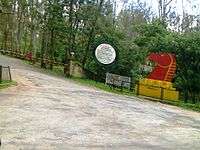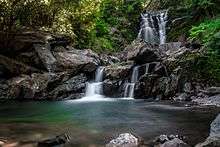Kudremukh
| Kudremukha | |
|---|---|
| Kudhure Mukha (Horse Face in Kannada) | |
|
Kudremukha - The Horse Face | |
| Highest point | |
| Elevation | 1,894 m (6,214 ft) |
| Coordinates | 13°07′46.24″N 75°16′06.79″E / 13.1295111°N 75.2685528°ECoordinates: 13°07′46.24″N 75°16′06.79″E / 13.1295111°N 75.2685528°E |
| Naming | |
| Translation | ಕುದುರೆಮುಖ (Kannada) |
| Geography | |
 Kudremukha Location of Kudremukha, Karnataka | |
| Location | Chikkamagaluru, Karnataka, India |
| Parent range | Western Ghats |
Kuduremukha is a mountain range and name of a peak located in Chikkamagaluru district, in Karnataka, India. It is also the name of a small hill station cum mining town situated near the mountain, about 48 kilometres from Karkala and around 20 kilometres from Kalasa. The name Kuduremukha literally means 'horse-face' (Kannada) and refers to a particular picturesque view of a side of the mountain that resembles a horse's face. It was also referred to as 'Samseparvata', historically since it was approached from Samse village. Kuduremukha is Karnataka's 3rd highest peak after Mullayangiri and Baba Budangiri. The nearest International Airport is at Mangalore which is at distance of 99 kilometres.[1]
Location
The Kudremukh National Park (latitude 13°01'00" to 13°29'17" N, longitude 75°00'55' to 75°25'00" E) is the second largest Wildlife Protected Area (600.32 km2) belonging to a tropical wet evergreen type of forest in the Western Ghats. Kudremukh National Park is located in Dakshina Kannada, Udupi District and Chikkamagaluru districts of the State of Karnataka. The Western Ghats is one of the thirty four hotspots identified for bio-diversity conservation in the world. Kudremukh National Park comes under the Global Tiger Conservation Priority-I, under the format developed jointly by the Wildlife Conservation Society (WCS) and World Wide Fund-USA.
Geography

The southern and western sides of the park form the steep slope of the Western Ghats ridge line, with the altitude varying from 100 m - 1892 m (peak). The northern, central and the eastern portions of the park constitute a chain of rolling hills with a mosaic of natural grassland and shola forests. Kudremukh receives an average annual rainfall of 7000 mm, largely due to the forest types of mainly evergreen vegetation that can be found here.
History

National park
Well known environmentalist and tiger expert undertook a detailed and systematic survey of the distribution of the endangered lion-tailed macaque in Karnataka during 1983-84 with support from the Government of Karnataka. He observed that suitable and extensive rainforest habitat for the lion-tailed macaque existed in Kudremukh and that the tract probably harboured the largest contiguous population of lion-tailed macaques in the Western Ghats, outside the Malabar region. He further suggested that lion-tailed macaques could be effectively used as a 'flagship' species to conserve the entire biotic community in the region and prepared a conservation plan for the survival of wild populations of lion-tailed macaques in the region delineating the present national park area as a proposed nature reserve. Based on his report, the Karnataka State Wildlife Advisory Board suggested to the government that Kudremukh National Park be created. Subsequently, in 1987, the Government of Karnataka declared these reserved forests as a national park based on the above suggestion.
Kudremukh National Park is spread partly over the thick hilly forests near the coastal plains on the western portion and the shola vegetation on the Western Ghats uplands, covering parts of three districts, viz., Chickmagalur, Udupi and Dakshina Kannada. The Kudremukh peak, by which the national park derives its name, is the highest spot at 1892 meters. The hills, which bear the brunt of the severe monsoon winds, preclude any tree growth added to that the region is known for its rich low grade magnetite soil which primarily inhibits plant growth. As a result, the landscape is covered with grass. The valleys which are tucked in, have reasonable protection from wind and a deep soil profile, as a result of which stunted evergreen forests exist creating a unique microclimate, rich with mosses, orchids, etc. The whole scenery of grassland interspersed with narrow strips of forests provides a fantastic vista.
Three important rivers, the Tunga, the Bhadra and the Nethravathi are said to have their origin here. A shrine of goddess Bhagavathi and a Varaha image, 1.8 m within a cave are the main attractions. The Tunga River and Bhadra River flow freely through the parklands. The area of the Kadambi waterfalls is a definite point of interest for anyone who travels to the spot. The animals found there include malabar civets, wild dogs, sloth bears and spotted deer.
Opposition to national park

People residing inside the national park did not welcome the idea of such a concept, as it involves eviction and Kudremukh Rashtriya Udyana Virodhi Okoota, an NGO, fights on behalf of people residing inside the forest and opposes the formation of the national park.[2] To curb the supposed naxalite activity inside the premises, police opened fire on activists and killed five suspected naxalites on 10 July 2007.[2]
Conservation
The Kudremukh range was declared a tiger reserve, as part of the Bhadra Tiger Sanctuary by the Union Environmental Minister, Government of India.
Ecology

A diverse assemblage of endangered large mammals is found in the park supporting three large mammal predator species such as the tiger, leopard and wild dog. The important tiger prey base found within the park is gaur, sambar, wild pig, muntjac, chevrotain, bonnet macaque, common langur and the lion-tailed macaque.
The wet climate and the tremendous water retentive capacity of the shola grasslands and forests have led to the formation of thousands of perennial streams in the region converging to form three major rivers of the region, Tunga, Bhadra and Nethravathi which form an important lifeline for the people of Karnataka and Andhra Pradesh. Lobo's house is an old abandoned farm on the upper reaches of Kuduremukha.
Mining town

The Kudremukh township developed primarily as an iron ore mining town where the government ran Kudremukh Iron Ore Company Ltd. (KIOCL). This public sector company operated for almost 30 years, but was closed in 2006 due to environmental issues.[3] The company proposed eco-tourism in the area and insisted that the land lease be renewed for 99 years.[3] However, environmentalists opposed such an idea on the grounds that the area should be given time to regenerate completely rest. Thus, the mining lease lapsed on 24 July 1999.[4]
Demographics
As of 2001 India census,[5] Kudremukh town had a population of 8095. Males constitute 54% of the population, while females constitute 46%. Kudremukh has an average literacy rate of 80%, which is higher than the national average of 59.5%; male literacy is 83% while female literacy is 77%. 11% of the population is under six years of age.
Stay at Kudremukh
At Kudremukh, the government provides shelter which includes tents and cottages. It is advisable to reserve well in advance before visiting the town. In recent times, some people have opened home stays and guest houses.
Trekking in Kudremukh


Trekking to the Kudremukh peak is permitted from 6:00 am to 5:00 pm (as per forest rules). The Lakya Dam there is drained most of the time and is not a very interesting place to visit. Hanuman Gundi Waterfalls, on the other hand, is a good place to visit; however, entry is allowed only from 10:00 am to 4:00 pm. Please note that if you are found wandering in the forest near the peak in the late hours without a guide or a local accompanying you, forest officers have the authority to detain you.
The locals of Kudremukh can be approached for any help and they are also very hospitable. Littering is prohibited everywhere in the Kudremukh area and in the mountains. If you are found littering while trekking you could be penalized. There are about 13 trekking routes in Kudremukh ranging from easy to tough. The well-known ones are:
- Samse - Kudremukh - Samse. The duration of this trek is around 4 days and 3 nights and it covers a total distance of about 40 km.
- Navoor - Hevala - Kudremukh - Navoor. The duration of this trek is around 5 days and 4 nights and it covers a total distance of about 60 km.
- Navoor - Kudremukh - Samse. The duration of this trek is around 5 days and 4 nights and it covers a total distance of about 50 km.
- Horanaadu - Sringeri. The duration of this trek is around 3 days and 2 nights and it covers a total distance of about 30 km.
- The Nature Camp in Kudremukh is one of the many beautiful places to stay.
Hanumana Gundi Waterfalls


Located 32 km (20 mi) from Kalasa, the waterfall spills onto natural rock formations from a height of more than 100 feet (30 m). Getting to the falls involves some trekking. The best time to visit the falls is between October and May.
Threats
Kudremukh Iron Ore Company Limited (KIOCL) is a government run company which was mining iron ore from the Kudremukh hills. KIOCL conducted its operations on an area of 4,604.55 ha for over 20 years. Opposition to its activities built up over the years from environmentalists and wildlife conservationists who were concerned about the threat to the region's flora and fauna, and farmers who were affected by the pollution of the streams that originated in the mining area. KIOCL has been banned from operating in this beautiful Natural Reserve, according to a Supreme Court order.
The rainfall in Kudremukh, which is one of the highest for any open cast mining operation in the world, greatly accentuates the impacts of siltation as claimed by environmentalists. The topographic and rainfall characteristics in combination with the open cast mining of low grade iron ore and other land-surface disturbances caused by the KIOCL operations resulted in very high sediment discharge, with over 60% of the total siltation in the Bhadra system being contributed by the mining area which forms less than six per cent of the catchment. With high quality practices adopted by KIOCL to mine, the flora and fauna remained intact, causing no adverse effects on the nature.
KIOCL used to send iron ore through pipes running through districts of Udupi and Dakshina Kannada and converted to pellets at their plant in Panambur.These pellets were exported to countries like China, Iran, Japan, etc. by ships.
Gallery
 Kudremukh Peak during fall
Kudremukh Peak during fall Kudremukh peak on 1/5/07
Kudremukh peak on 1/5/07- Shola Forests of Kudremukh
- Kudremukh from a distance
 Kudremukh range
Kudremukh range the hills of Kuduremukha range during rain fall
the hills of Kuduremukha range during rain fall view from top
view from top the forest covered hill
the forest covered hill Shola forest
Shola forest view from top
view from top
See also
References
- ↑ "Distance Between Mangalore To Kudremukha". Retrieved 15 April 2017.
- 1 2 Prabhu, Ganesh (12 July 2007). "Kudremukh park: eviction threat looms over Megur". Retrieved 10 June 2013.
- 1 2 "KIOCL plans to enter eco-tourism sector with a Rs. 805-cr. investment". The HIndu. 2 April 2013. Retrieved 10 June 2013.
- ↑ "Greens seek to steamroll KIOCL’s luxury eco-tourism project". 4 April 2013. Retrieved 10 June 2013.
- ↑ "Census of India 2001: Data from the 2001 Census, including cities, villages and towns (Provisional)". Census Commission of India. Archived from the original on 2004-06-16. Retrieved 2008-11-01.
External links
| Wikimedia Commons has media related to Kudremukh. |
- kudremukh trek
- Checklist of Amphibians reported from Kudremukh National Park
- Checklist of Aquatic Insects reported from Kudremukh National Park
- Checklist of Birds reported from Kudremukh National Park
- Checklist of Butterflies reported from Kudremukh National Park
- Checklist of Fishes reported from Kudremukh National Park
- Checklist of Mammals reported from Kudremukh National Park
- Checklist of Non-Woody Plants reported from Kudremukh National Park
- Checklist of Reptiles reported from Kudremukh National Park